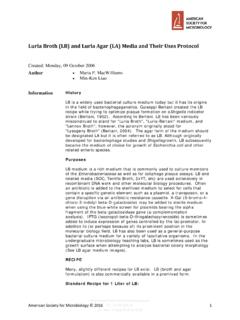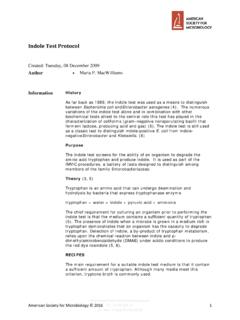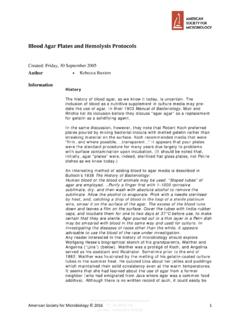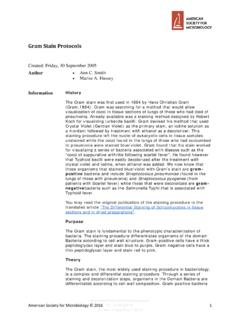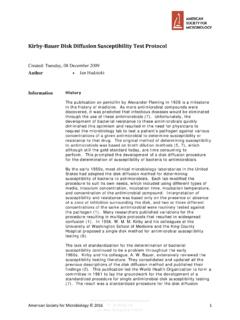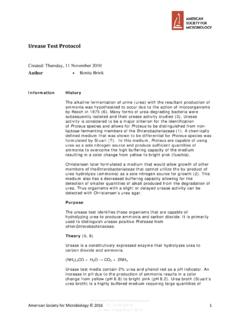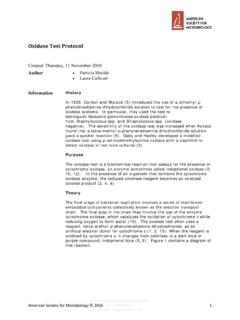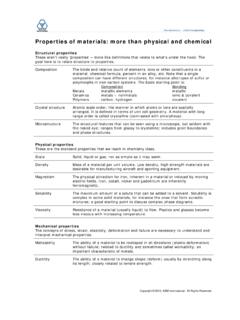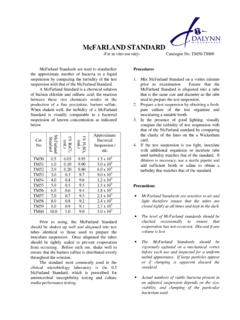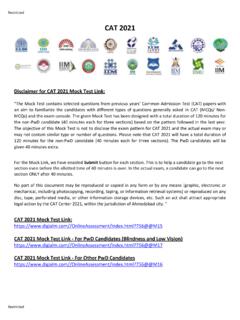Transcription of Microorganisms, Mold, and Indoor Air Quality
1 Microorganisms, Mold, andIndoor Air QualityINDOOR AIR QUALITYM icroorganisms, Mold, and Indoor Air QualityContributing AuthorsLinda D. Stetzenbach, ,Chair, Subcommittee on Indoor Air Quality , University of Nevada, Las VegasHarriet Amman, ,Washington Department of EcologyEckardt Johanning, , ,Occupational and Environmental Life ScienceGary King, ,Chair, Committee on Environmental microbiology , University of MaineRichard J. Shaughnessy, ,University of TulsaAbout the american society for MicrobiologyThe american society for microbiology (ASM) is the largest single life sciencesociety, composed of over 42,000 scientists, teachers, physicians, and healthprofessionals.
2 The ASM s mission is to promote research and research trainingin the microbiological sciences and to assist communication between scientists,policymakers, and the public to improve health, economic well being, and theenvironment. The goal of this booklet is to provide background information on indoorair Quality (IAQ) and to emphasize the critical role of research in responding to IAQand public health issues which currently confront 2004 With every breath, we inhale notonly life sustaining oxygen but alsodust, smoke, chemicals, microor-ganisms, and other particles and pollutants thatfloat in air.
3 The average individual inhales about10 cubic meters of air each day, roughly the vol-ume of the inside of an elevator. Because peopletypically spend so much time indoors, poorindoor air Quality (IAQ) can greatly affect indi-viduals and, more broadly, the public health andnational productivity. The US EnvironmentalProtection Agency (EPA) Science Advisory Boardrated Indoor air pollutants, excepting radon, asthe third highest of 30 environmental risks, wellahead, of sixth ranked occupational exposures tochemicals. However, a shortage of IAQ researchleaves us with too many unknowns, even as moreand more occupants of contaminated buildingsare reporting a variety of health symptoms thatthey attribute to poor IAQ.
4 This also leads tohealth treatment, expensive remediation activi-ties, and poor IAQ is often viewed as a prob-lem peculiar to modern buildings, linkagesbetween air Quality and disease have been knownfor centuries. Long before the germ theory of dis-ease led to recognition of pathogenic microorgan-isms, foul vapors were being linked withinfectious diseases. As our understanding of dis-ease increased, public health workers made pre-vention of pathogen transmission a centralconcern. Today, we understand that airbornetransmissions of pathogens, non-pathogenicorganisms, fragments of microbial cells, andbyproducts of microbial metabolism, collectivelyreferred to as bioaerosols, can all cause seriousproblems.
5 Contaminated Indoor air thus has thepotential to harm public health and significantlyaffect the economy of the United States and view of acluster ofAspergillus fumigatusconidiophores and view ofPenicillium chyrsogenumconidiophores cavity of a restroom with visible mold resultingfrom plumbing AIR QUALITYA lthough the Centers for Disease Control andPrevention (CDC) does not track either the typesor cases of illness attributable to bioaerosol expo-sure, bioaerosols are widely recognized to makeasthma worse ( ). Asthma affects anestimated 20 million Americans and costs the USeconomy more than $13 billion annually.
6 TheAmerican Lung Association cites asthma as thesixth ranking chronic condition in the UnitedStates as well as the leading serious chronic illnessof children, with numbers of those affected risingeach year. In a recent report, the Institute ofMedicine (IOM; ) concluded that there is sufficient evidence of an associationbetween exposure to a damp Indoor environmentand asthma symptoms in sensitized asthmaticpeople and that there is a sufficient evidence ofan association between the presence of mold (otherwise unspecified) in a damp Indoor envi-ronment and asthma symptoms in sensitizedasthmatic people.
7 The US Government Accountability Office(GAO) reports that an estimated 20 percent of allschools in the United States have Indoor air prob-lems. Moreover, the general public is becomingincreasingly aware of IAQ problems. Over 3,500news reports related to mold toxicity have beenpublished since 2000, and some 10,000 moldrelated lawsuits are pending nationwide. Many ofthese lawsuits have been filed in regions with hot,humid climates, but construction defects andinferior maintenance practices can lead to build-ings with poor Indoor air Quality anywhere in thisor other countries.
8 2 Water stained ceiling tile from an office buildingwith chronic roof of Trichodermashowing fluffy, spreadinggrowth on the agar mold growing on a floor joist in the crawl spaceunder a residence with chronic water are collections of airborne biologicalmaterials. Ubiquitous indoors and out, bioaerosolsin suspended, aerosolized liquid droplets typicallycontain microbes and cell fragments combinedwith byproducts of cellular metabolism. In addition,they may carry viruses, bacteria, and fungi that floaton dust particles along with cells and parts of there are no recognized standard levelsfor bioaerosols in schools, offices, and residentialenvironments, several government agencies andprofessional organizations have published guid-ance documents that address bioaerosol concernsas an integral component of & organizations that havepublished guidance documents onbioaerosols.
9 american Industrial HygieneAssociation (AIHA) California Department of HealthServices Occupational Safety and HealthAdministration (OSHA) US Environmental Protection Agency (US EPA) require a living host for replication,meaning they cannot by themselves multiply onor in building materials. However, they can con-taminate interior spaces of manmade or naturalstructures such as occurred when Hantavirus infec-tions resulted among building occupants becauserodents had infested particular Indoor environ-ments. More commonly, many viruses that infectthe respiratory tract spread from person to person,especially in crowded rooms with inadequate ven-tilation thus making viruses common factors inpoor IAQ.
10 Coughing, laughing, and sneezing candischarge tens of thousands of virus filled dropletsinto the air and may readily spread illnesses inschools, offices, homes, or other and FungiIn contrast to viruses, bacteria and fungi willgrow, often to an alarming extent, on buildingmaterials if moisture is available. Background levelsof airborne bacteria and fungi change frequentlyinside buildings as a result of human activity,especially operation of mechanical air handlingsystems. Indeed, building conditions that allowexcessive growth of bacteria or fungi can lead tooccupants developing various specific medicalsymptoms or other complaints.

